Now that we’ve evaluated the Detroit Red Wings as a whole, we can turn to the individual skaters. Some—like Lucas Raymond, Moritz Seider, and Marco Kasper—performed extremely well. Others did not.
To evaluate the 2024-25 Red Wings, we’ll look at their preseason projections, roles, production, deployment, and more before assigning a grade.
2024-25 Red Wings Player Data
Below are the scoring projections for the 2024-25 Red Wings that I shared prior to the season. Expected roles, historical data, age, contract status, and other factors played into these calculations.
| Player | GP | G | A | PTS |
| Dylan Larkin | 76 | 35 | 43 | 78 |
| Lucas Raymond | 82 | 29 | 43 | 72 |
| Alex DeBrincat | 80 | 31 | 39 | 70 |
| Patrick Kane | 72 | 22 | 40 | 62 |
| Vladimir Tarasenko | 74 | 21 | 31 | 52 |
| Moritz Seider | 80 | 8 | 42 | 50 |
| J.T. Compher | 80 | 20 | 27 | 47 |
| Jonatan Berggren | 67 | 18 | 25 | 43 |
| Andrew Copp | 78 | 12 | 24 | 36 |
| Michael Rasmussen | 74 | 14 | 19 | 33 |
| Simon Edvinsson | 72 | 6 | 22 | 28 |
| Erik Gustafsson | 70 | 5 | 23 | 28 |
| Joe Veleno | 74 | 12 | 13 | 25 |
| Christian Fischer | 76 | 9 | 13 | 22 |
| Jeff Petry | 64 | 4 | 17 | 21 |
| Ben Chiarot | 80 | 6 | 15 | 21 |
| Olli Maatta | 64 | 3 | 11 | 14 |
| Tyler Motte | 72 | 6 | 7 | 13 |
| Albert Johansson | 58 | 3 | 10 | 13 |
In addition, I’ve plotted the five-on-five expected goals for and against on a per 60 basis for the 2024-25 Red Wings. This helps identify which players were able to contribute to high-quality chances for, plus their ability to defend high-quality chances against.
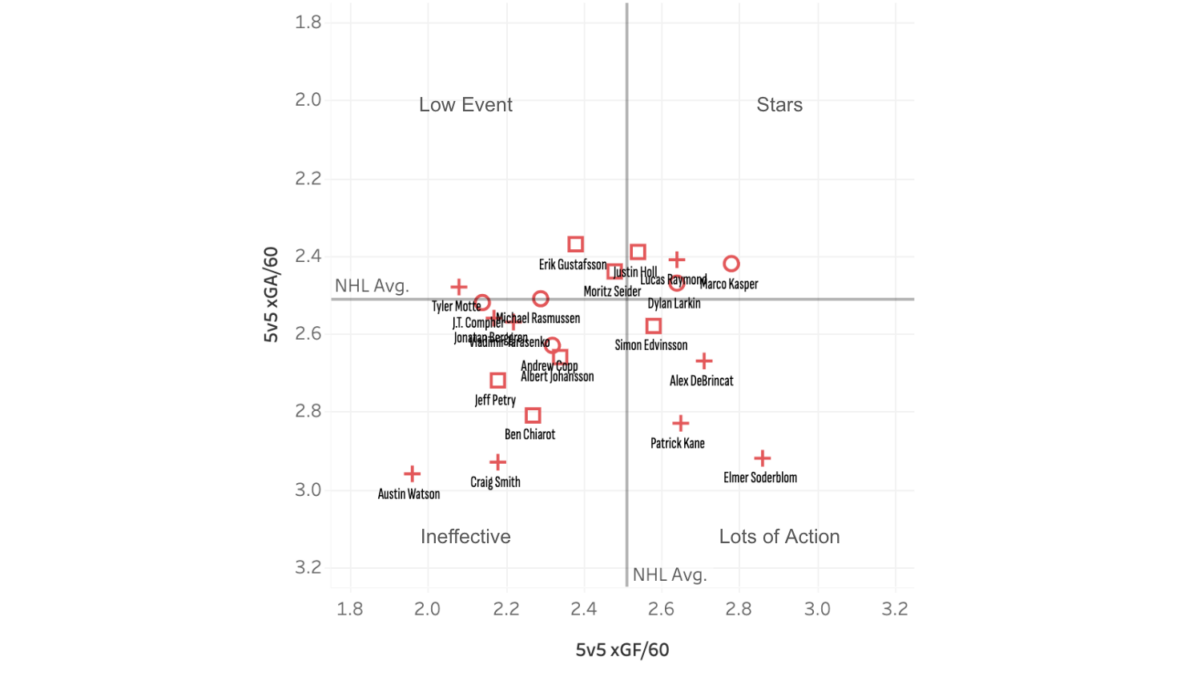
Lastly, the chart below depicts how much time Detroit’s skaters faced off against elite competition and their high-quality chance share while deployed.
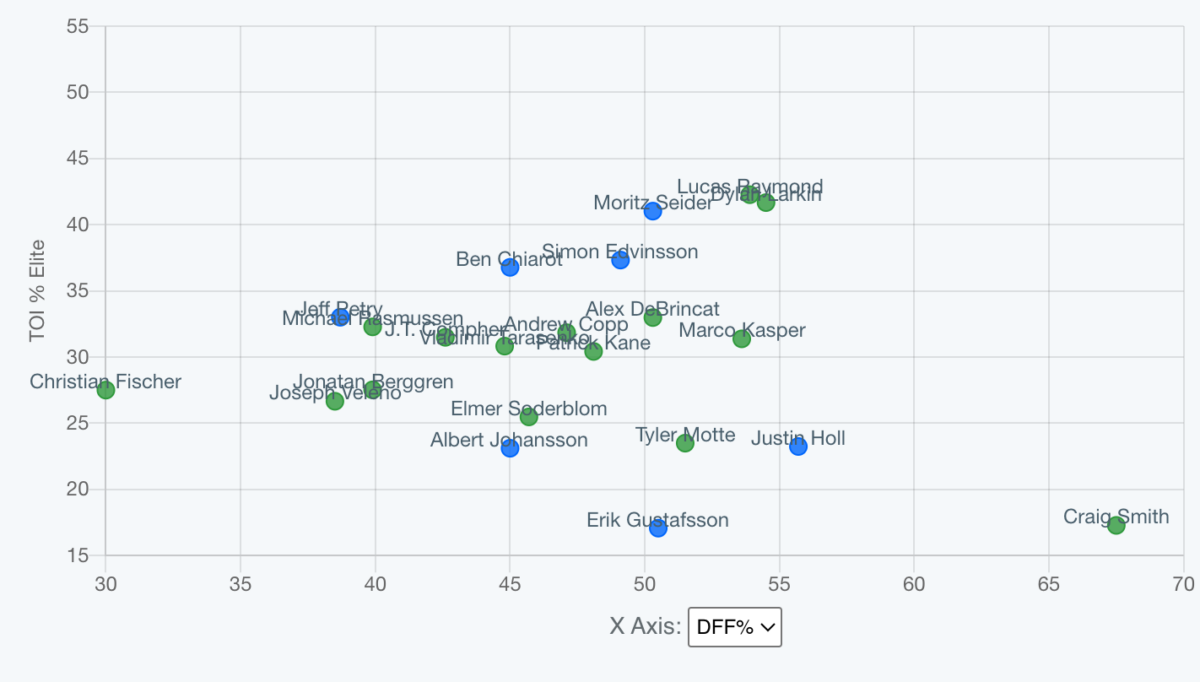
2024-25 Red Wings Player Evaluations
Next, we’ll take the inputs above and combine them with additional data to evaluate the 2024-25 Red Wings based on their expected role. Two players can have the same grade, but have vastly different seasons. It’s all about expectations going in, and what the player did in that role.
- A – Star-level performance, outperformed role
- B – Reliable and effective, met or slightly exceeded role
- C – Adequate, but replaceable
- D – Struggled relative to usage and expectations
Lastly, players who were traded away, those who appeared in less than 10 games were, and goalies were excluded. Now let’s dive in.
Jonatan Berggren – LW
Stats: 75 GP – 12 G – 12 A – 24 PTS
Role: Depth forward with part-time power play role
Analysis: Berggren was expected to produce more in 2024-25, but saw Marco Kasper take valuable ice time away from him. His defensive zone play left much to be desired and his skill set didn’t align well with Detroit’s other depth forwards. Still, Berggren’s above-average playmaking microstats represent some promise for the future.
Rating: C-
Ben Chiarot – LD
Stats: 81 GP – 4 G – 9 A – 13 PTS
Role: Top-four (and often top-pair) defenseman with penalty kill role
Analysis: The Red Wings asked a lot of Chiarot in 2024-25. He played the sixth-most minutes versus elite competition among NHL blueliners and held his own when paired with Seider. He was a liability without his star partner, though. In general, the top four is an overslot for Chiarot given the lack of offensive production while he’s on the ice and the dependence on Seider to carry the load.
Rating: C-
J.T. Compher – C
Stats: 76 GP – 11 G – 21 A – 32 PTS
Role: All-situations, middle-six center
Analysis: If the ask of Compher was/is to be a third-line center, then he was fine. Anything more is an overslot. His offensive numbers were way down compared to projections and he wasn’t able to establish chemistry with Alex DeBrincat and Patrick Kane – two of Detroit’s best offensive players. Defensively, Compher struggled – he was outchanced by elite, middle, and replacement-level opponents. Fortunately, not many pucks went in – his 1.9 GA/60 at five on five was tied with Kane for best on the team. That didn’t translate to the penalty kill, though, where he was on the ice for way too many goals against.
Rating: D+

Andrew Copp – C
Stats: 56 GP – 10 G – 13 A – 23 PTS
Role: All-situations, middle-six center
Analysis: It was clear that the Red Wings missed Copp after he tore his pectoral muscle shortly after the 4 Nations break. He had taken Compher’s 2C role earlier in the year and hadn’t given it up. Overall, Copp’s points per 60 lined up with his scoring projections, and he registered proficient defensive zone and forecheck microstats, all the while overindexing in defensive zone starts. But again, the injury was a big blow to the Red Wings – it made their penalty kill even worse and highlighted depth and overslotting issues.
Rating: B-
Alex DeBrincat – RW
Stats: 82 GP – 39 G – 31 A – 70 PTS
Role: Top-line forward with power play role
Analysis: This year’s DeBrincat was the player Detroit traded for back in 2023. He almost reached 40 goals, scored on pace with projections, tied for fifth in NHL for power play goals (14), and topped his 2023-24 performance offensively. Generally speaking, it was a more consistent year for DeBrincat. That also extended to the defensive and neutral zones – he was dependable versus elite competition throughout the year. DeBrincat also scored highly in terms of zone exit and zone entry microstats.
Rating: A
Simon Edvinsson – LD
Stats: 78 GP – 7 G – 24 A – 31 PTS
Role: Top-four (and often top-pair) defenseman with penalty kill role
Analysis: There were high hopes for Edvinsson, and he somehow exceeded them. He had the 10th-most difficult deployment among NHL defensemen and maintained a positive goal share against the league’s best. He also produced strong numbers when it came to defending the blueline and denying zone entries. Alongside Seider, the two limited opponents to 1.44 goals against per 60, which ranked third-best among defensive pairs that played 400-plus minutes of five-on-five hockey. Offensively, Edvinsson scored on pace with projections and showed a willingness to jump into the play, resulting in above-average zone entry microstats.
Rating: A
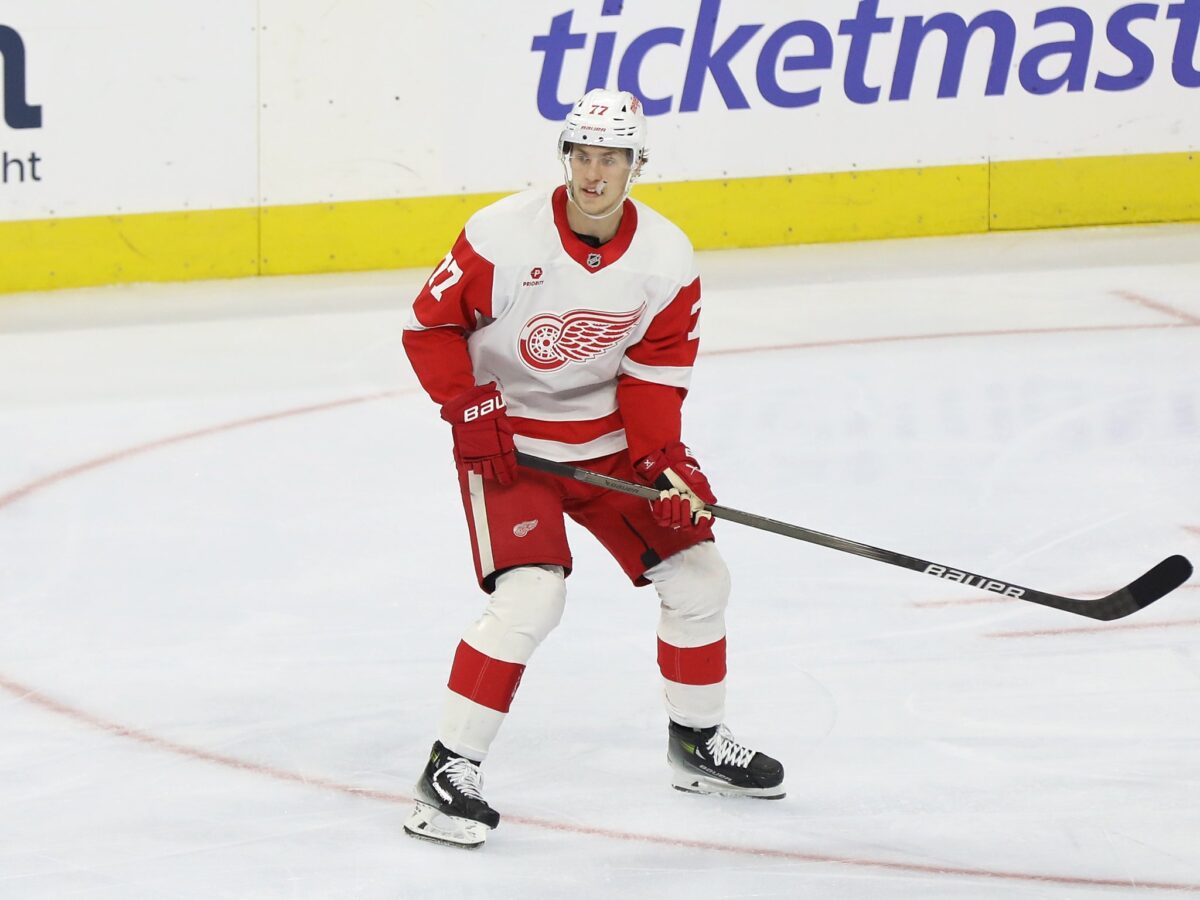
Erik Gustafsson – LD/RD
Stats: 60 GP – 2 G – 16 A – 18 PTS
Role: No. 4/5 defenseman with power play role
Analysis: Gustafsson was given a difficult assignment in making up (some of) the lost offense stemming from Jake Walman and Shayne Gostisbehere’s departures. He did not live up to the task. Gustafsson fell short of projections – the lack of power play success was a main driver of that. He did a solid enough job when it came to offensive zone entries and generating five-on-five opportunities in a limited role. But that was offset by far too many failed defensive zone exits and turnovers. His 4.92 turnovers per 60 at five on five was the seventh-most in the NHL among defensemen who played 500-plus minutes.
Rating: D+
Justin Holl – RD
Stats: 73 GP – 2 G – 6 A – 8 PTS
Role: Depth defenseman with penalty kill role
Analysis: For someone who was waived prior to the season with seven defensemen ahead of him on the depth chart, it’s impressive that Holl suited up for 75 games this season and produced solid penalty kill numbers relative to the rest of the team. That said, there was almost negative offense when Holl was on the ice. He also struggled with zone exits and could not be counted on to be physical around the net. But expectations for Holl were minimal entering the season, and his steady, low-event style of play was sufficient to earn an “adequate” grade, given the low threshold set up front.
Rating: C-
Albert Johansson – LD/RD
Stats: 61 GP – 3 G – 6 A – 9 PTS
Role: Depth defenseman
Analysis: Johansson was fine. He was fine as a third-pairing-level defender in his first NHL season. He was fine against mid- and replacement-level competition. At some points, he struggled to get into the lineup; at others, he excelled when matched up against Connor McDavid. That nets out to fine. Plus, there were some flashes of offensive potential and Johansson performed well when it came to defensive zone retrievals.
Rating: C+
Patrick Kane – LW
Stats: 72 GP – 21 G – 38 A – 59 PTS
Role: Top-six forward with power play role
Analysis: Kane finished right around where he was expected to in terms of scoring, which was great to see given the fact that this was his first full season after his 2023 hip surgery. He was a strong driver of zone entries at both five on five and on the power play – the latter of which contributed to Detroit’s ninth-best zone entry success rate with the man advantage. In addition, Kane’s 8.37 power play points per 60 ranked in the top 10 league-wide. And finally, his defensive metrics were average, but that was a good thing given his penchant to lean more into the offensive side of the game.
Rating: B+
Marco Kasper – C
Stats: 77 GP – 19 G – 18 A – 37 PTS
Role: N/A
Analysis: Another bright spot, Kasper was sent down to Grand Rapids initially, got the call-up, remained in the lineup, and then became one of Detroit’s best players in the second half. He was fifth in team scoring under Todd McLellan with 30 points in the final 48 games, and effectively seized the 2C role. Kasper was a strong driver offensively in terms of goals, expected goals, high-danger chances, and rebounds created. He also played the fourth-most minutes against elite competition among Red Wings forwards and sported a positive goal and chance share. His defensive zone microstats showed he had a clear impact around his own net as well.
Rating: A
Dylan Larkin – C
Stats: 82 GP – 30 G – 40 A – 70 PTS
Role: All-situations 1C
Analysis: What was an impressive season was upended by an injury sustained during the 4 Nations Face-Off. Down the stretch, Larkin just didn’t look comfortable, and struggled to maintain his scoring pace and reach his projection. Still, it was a good year for Detroit’s captain. He survived being tasked with the most difficult deployment among Red Wings forwards—second-most difficult among forwards league-wide—and tied for 13th in the NHL with 13 power play goals. He was also good at both ends of the ice during five-on-five play and transitioned the puck up ice well. Overall, Larkin was good – but he needs to be great as the 1C for the team to succeed.
Rating: B
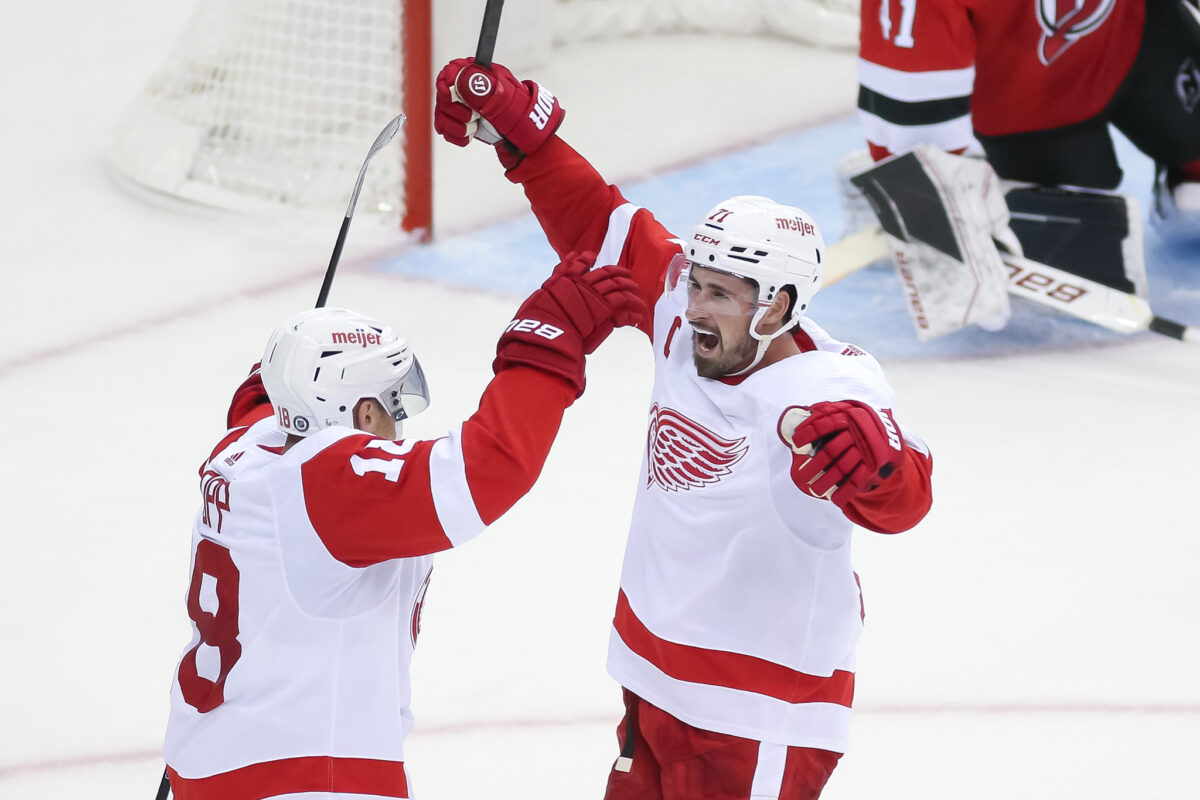
Tyler Motte – LW/C
Stats: 55 GP – 4 G – 5 A – 9 PTS
Role: Depth forward with penalty kill role
Analysis: Motte had poor box score metrics in 2024-25, but that was to be expected. That said, the versatile forward did have strong underlying numbers for his sheltered five-on-five role, especially individual high-danger chances per 60 and rush chances per 60. Otherwise, he was average on a (well-) below-average penalty kill.
Rating: C-
Jeff Petry – RD
Stats: 44 GP – 1 G – 7 A – 8 PTS
Role: Second-pair defenseman with some special teams contributions
Analysis: Petry had good chemistry with Edvinsson (57.14 percent goal share), and otherwise was an adequate third-pairing defenseman in terms of deployment effectiveness, zone exits, and production. That’s where he should be slotted – Detroit gave him second-pairing minutes because they really didn’t have anyone else that fit the mold. He was effective – just not in the role that was originally assigned. That only goes for five-on-five play, though. Petry registered poor penalty kill numbers relative to the rest of the team, and the team’s performance was poor in it of itself.
Rating: C-
Michael Rasmussen – C/LW
Stats: 77 GP – 11 G – 10 A – 21 PTS
Role: Third-line forward with penalty kill role and lineup versatility
Analysis: Rasmussen fell short of his statistical projections in 2024-25. For someone skating in the middle six, you simply need to produce more offensively. He recovered dump-ins well and had decent passing microstats, though. But on the other hand, there’s much to be desired when it comes to Rasmussen’s physicality and decision-making. And like Petry above, he struggled to kill penalties effectively. It was not a good year for Rasmussen.
Rating: D+
Lucas Raymond – LW
Stats: 82 GP – 27 G – 53 A – 80 PTS
Role: Top-line forward with power play role
Analysis: It was a banner campaign for Raymond. His 80 points led the team and gave the Red Wings their first 80-point producer since 2010-11. Raymond’s microstats were impressive, too – he ranked highly when it came to zone exits with possession, entering the offensive zone, and passing in general. Raymond’s production—when combined with the fifth-most difficult deployment across the NHL—is truly impressive. Plus, he finished fourth in the league with 8.79 power play points per 60.
Rating: A
Moritz Seider – RD
Stats: 82 GP – 8 G – 38 A – 46 PTS
Role: All-situations 1D
Analysis: Seider was entrusted as the go-to guy on defense, and he rose to the challenge. According to Hockey Stat Cards, he ranked eighth among all defensemen in defensive rating – an impressive feat made even more notable by the fact that he logged the most minutes against elite competition across the NHL. And despite facing the toughest deployment in the league, Seider still maintained a positive goal and chance share against elite opponents. His defensive zone microstats were mostly excellent and he even managed to produce close to his preseason scoring projections. Lastly, Seider finished ninth among NHL blueliners with 24 power play points.
Rating: A
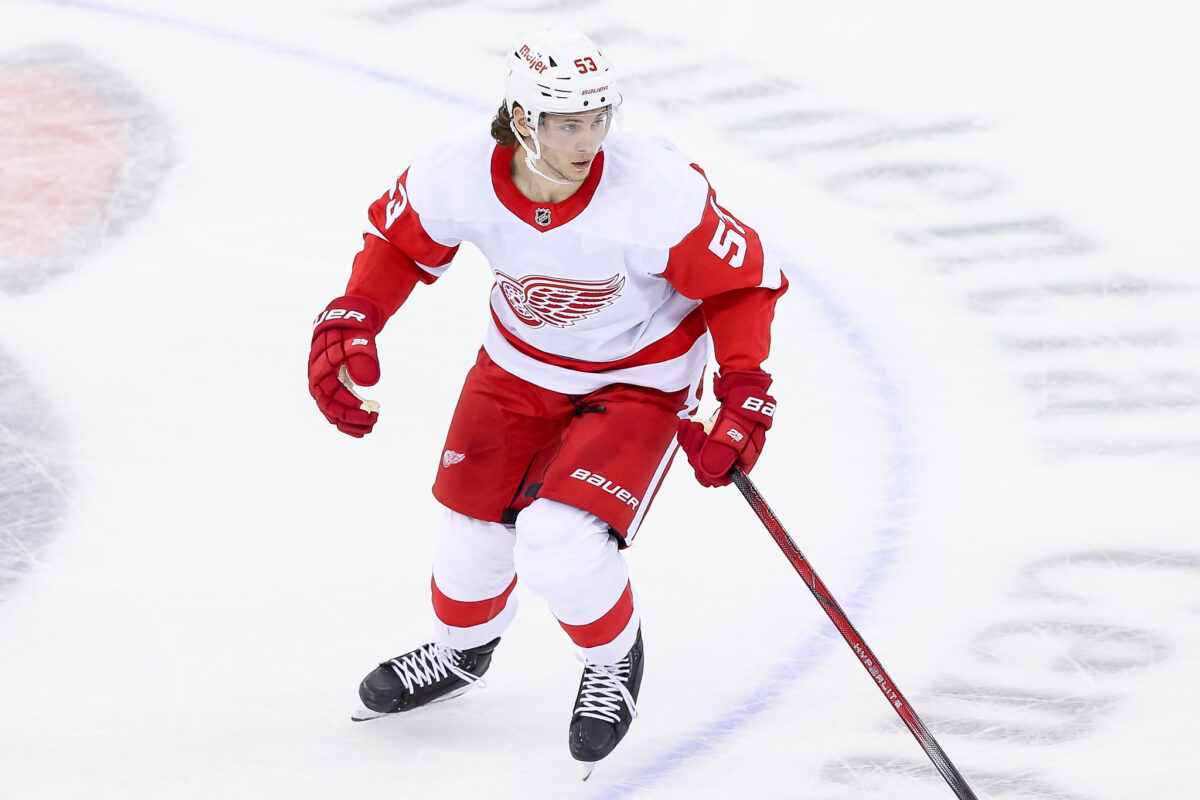
Craig Smith – RW
Stats: 19 GP – 0 G – 2 A – 2 PTS
Role: N/A
Analysis: Smith provided energy and not much else after being acquired from the Blackhawks. He was given sheltered deployments and didn’t generate much offense, though he did rate highly in terms of takeaways and blocked shots. He had a few too many giveaways in limited ice time, though.
Rating: Inc.
Elmer Soderblom – LW
Stats: 26 GP – 4 G – 7 A – 11 PTS
Role: N/A
Analysis: Soderblom seized the opportunity once he got the call-up to Detroit. His 5.25 five-on-five iHDCF/60 ranked 11th among NHL skaters with 100-plus minutes played. In addition, his 0.72 goals per 60 at five on five topped all of Detroit’s depth forwards. And despite moving up and down the lineup, Soderblom helped generate an above-average amount of shots off the forecheck and scored well in terms of controlled entries. In my opinion, Soderblom should absolutely start the 2025-26 season in Detroit.
Rating: B+
Vladimir Tarasenko – RW
Stats: 80 GP – 11 G – 22 A – 33 PTS
Role: Top-six forward with power play role
Analysis: Tarasenko’s first year in Detroit was not a good one. He fell well short of scoring projections and his 2023-24 totals. In addition, he was a black hole defensively, with almost all defensive microstats ranking poorly. He wasn’t a good fit in Detroit’s top six, and then couldn’t generate much offense after being dropped down to the third line with Compher and Berggren. There were a few positives – he did a decent job creating offensive off of controlled entries and setting up high-danger chances. But given his role entering the season and his cap hit, Tarasenko needed to produce more in 2024-25.
Rating: D-
Austin Watson – RW
Stats: 13 GP – 3 G – 0 A – 3 PTS
Role: N/A
Analysis: Watson brought physicality and energy to the lineup when called upon, and even scored three goals playing limited minutes. He got cratered from a defensive standpoint, though, and that was mostly against replacement-level competition.
Rating: Inc.
Final Word
Overall, Detroit’s core and younger players performed well. Obviously, this is great to see – the building blocks are doing what they’re supposed to.
Related: How Much Did the Red Wings Improve Under Todd McLellan?
On the other hand, the stopgap players generally rated poorly. This calls into question their role, and if they’re better suited for something lesser – or to be removed from the roster altogether.
Now, we can take this information and evaluate Detroit’s organizational depth. Combined, we can start to see what areas Steve Yzerman needs to address this offseason and which players can fill those roles.
Data courtesy of PuckIQ, All Three Zones, NHL.com, Hockey Stat Cards, and Natural Stat Trick.
